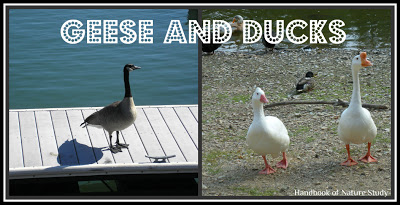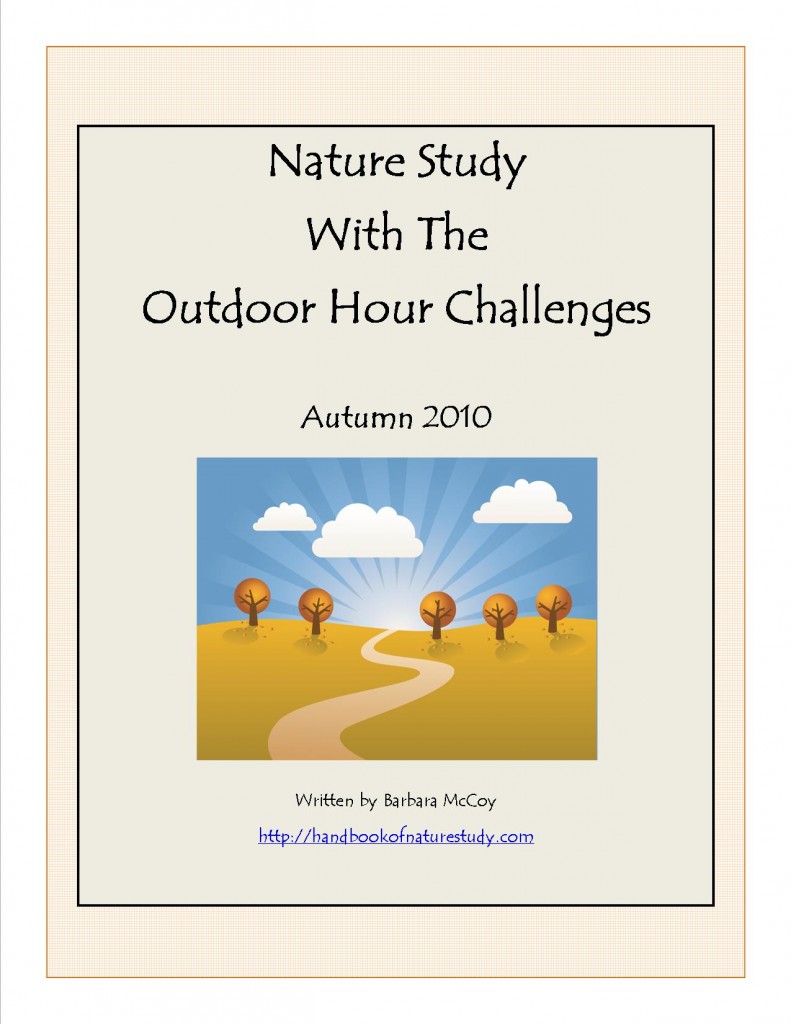Autumn Series #2
Bird Study: The Goose
“And there is not a more interesting sight anywhere in the autumn landscape than the wedge-shaped flock of these long-necked birds with their leader at the front apex.” Handbook of Nature Study, page 133
Inside Preparation Work:
1. Read pages 130-135 in the Handbook of Nature Study (Lesson 34). Take special note of the fact that the northern migration of wild geese takes place in April and May, and the southern journey is from October to December. (Check this website for a map of where Canada Geese live in North America.)
2. Listen to the sound of Canada Geese and Snow Geese. Many times we will hear a goose before we see it flying overhead. Use your sense of hearing to help you identify a goose when the opportunity arises.
Comparison Ideas:
- What do ducks eat and what do geese eat? (Hint: Where do they look for food?)
- Compare the duck’s and the goose’s beak, the length of their legs, and the shape of their necks.
- Compare the color of their feathers, beak, eyes, and feet.
- Do they both swim in the same way? How about flying?
- Are there some feathers on the ground to observe and compare?
- What does each bird sound like?
- Are they friendly, shy, or aggressive?
Outdoor Hour Time:
Take the opportunity during this challenge to find a local duck pond and check to see if there are any geese visiting at this time. You also might try a local farm that may have geese and ducks for you to observe. Use your Outdoor Hour time to observe geese and/or ducks with the suggestions from the Handbook of Nature Study as well as those suggested above. Help your child to find words to compare the goose to some other bird they already know as far as shape, size, and habits.
If you do not have any geese or ducks to observe, you can observe any of your backyard birds and make some comparisons. This activity is one that can be done with any bird at any time. Work on your observation skills a little each week to sharpen your child’s awareness of their own surroundings.
Follow-Up Activity:
Take a few minutes to talk briefly about what you saw during your Outdoor Hour time. If you observed geese and/or ducks, use the gentle reminder questions in the list above to stimulate a little conversation. Your child can also record their observations in their own blank nature journal or use the notebook page from the ebook for convenience. You may wish to pull up the website listed in the preparation work to view more photos of geese to make sketching a little easier. In the Autumn 2010 ebook, there is a printable notebook page for a goose and another more general page for an autumn bird study of any bird.
If you did not observe a goose or duck, you can still complete a nature journal page or notebook page for any bird you did observe. Use your field guide or AllAboutBirds.org to glean more information if desired.
Note: This nature study challenge can be found in the Autumn 2010 ebook.
If you would like to own this ebook, it is part of the Ultimate Naturalist Library for members. You can find more details on how to get your own membership here: Join Us!




Hi Barb! Great post. We featured the White Ibis ..how Floridian is THAT? 🙂
awesome idea. and since we have ducks and 2 types of geese I’m going to modify and head out with the kids. Love it! Thanx!
We just loved this study. Thank you for organizing it. We extended it by a visit to a neighbor that keeps geese and making a “flying geese” paper quilt.
Hi Barb-
I just noticed that somehow I entered my blog three times. So sorry!
Yet another time we learned so much about something we already thought we knew a bunch about. Thank you!
We had a pleasant hour of Geese study while it was pouring outside. I bet the neighbours thought geese were flying over, since we did some great imitations of their sounds: ‘Gak-Gak or Honk-Honk’.
Thank you Barb, for the resources and inspiration.
Here is our link:
http://web.me.com/kuitenbrouwer/Paula_Kuitenbrouwer/Boekenblog/Entries/2010/9/28_NATURE_STUDIES__SERIES_2.html
I posted to the carnival but forgot to come back here. Maybe I shouldn’t blog at night. 🙂 Can’t wait to read the other’s posts!
Thanks for the idea. It was a great jumping off point for my boys, who enjoyed the birds, and the bugs, and the water. We might even get to see geese soon as the Bird Preserve near us re-opens next week.
Geese are a personal favorite of mine!
Love seeing what everyone else did!
Hi We had a great time reading and drawing the birds. Thanks for leading these studies.
Monica
My eldest loved drawing the geese. My middle loved playing in the rain watching me feed the geese. Thanks for this study!
Great brainstorming activity for the kids and they loved going out to look at all the geese and ducks! Thanx!
My 10 yr old daughter who we affectionately refer to as “Bird Girl” is so excited that the cooler weather has begun and can be found almost anytime of day watching out the window or out near the woods for the migrators. We were blessed to have a handful of yellow-rumped warblers visit our deck all week long in search of insects clinging to the house for warmth. These are our first warbler sightings and she is thrilled to be able to add them to her life list. She would love to have a new field guide as ours is quite old and she says it is missing so many birds.
Hi Barb,
We enjoyed our study – even though we didn’t see any geese. We did observe Mallards and a Great Egret though. Thank you for the challenge!
Thanks Barb! Great study.
we FINALLY completed our study today 🙂 Better late than never 😉 LOL Thanks for an awesome study!